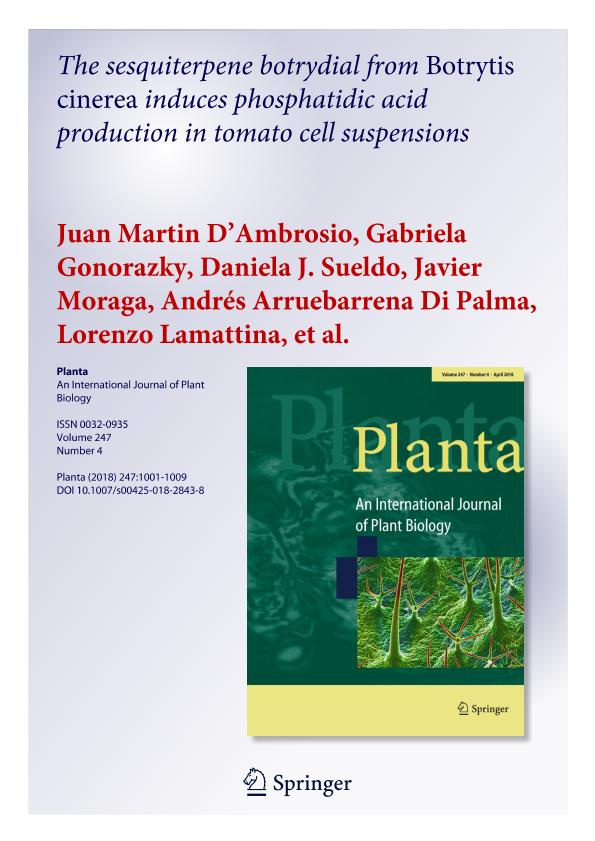Mostrar el registro sencillo del ítem
dc.contributor.author
D'ambrosio, Juan Martín

dc.contributor.author
Gonorazky, Ana Gabriela

dc.contributor.author
Sueldo, Daniela Jorgelina

dc.contributor.author
Moraga, Javier
dc.contributor.author
Arruebarrena Di Palma, Andrés

dc.contributor.author
Lamattina, Lorenzo

dc.contributor.author
Collado, Isidro González
dc.contributor.author
Laxalt, Ana Maria

dc.date.available
2019-10-28T17:25:01Z
dc.date.issued
2018-04
dc.identifier.citation
D'ambrosio, Juan Martín; Gonorazky, Ana Gabriela; Sueldo, Daniela Jorgelina; Moraga, Javier; Arruebarrena Di Palma, Andrés; et al.; The sesquiterpene botrydial from Botrytis cinerea induces phosphatidic acid production in tomato cell suspensions; Springer; Planta; 247; 4; 4-2018; 1001-1009
dc.identifier.issn
0032-0935
dc.identifier.uri
http://hdl.handle.net/11336/87400
dc.description.abstract
Main conclusion: The phytotoxin botrydial triggers PA production in tomato cell suspensions via PLD and PLC/DGK activation. PLC/DGK-derived PA is partially required for botrydial-induced ROS generation. Phosphatidic acid (PA) is a phospholipid second messenger involved in the induction of plant defense responses. It is generated via two distinct enzymatic pathways, either via phospholipase D (PLD) or by the sequential action of phospholipase C and diacylglycerol kinase (PLC/DGK). Botrydial is a phytotoxic sesquiterpene generated by the necrotrophic fungus Botrytis cinerea that induces diverse plant defense responses, such as the production of reactive oxygen species (ROS). Here, we analyzed PA and ROS production and their interplay upon botrydial treatments, employing tomato (Solanum lycopersicum) cell suspensions as a model system. Botrydial induces PA production within minutes via PLD and PLC/DGK. Either inhibition of PLC or DGK diminishes ROS generation triggered by botrydial. This indicates that PLC/DGK is upstream of ROS production. In tomato, PLC is encoded by a multigene family constituted by SlPLC1–SlPLC6 and the pseudogene SlPLC7. We have shown that SlPLC2-silenced plants have reduced susceptibility to B. cinerea. In this work, we studied the role of SlPLC2 on botrydial-induced PA production by silencing the expression of SlPLC2 via a specific artificial microRNA. Upon botrydial treatments, SlPLC2-silenced-cell suspensions produce PA levels similar to wild-type cells. It can be concluded that PA is a novel component of the plant responses triggered by botrydial.
dc.format
application/pdf
dc.language.iso
eng
dc.publisher
Springer

dc.rights
info:eu-repo/semantics/openAccess
dc.rights.uri
https://creativecommons.org/licenses/by-nc-sa/2.5/ar/
dc.subject
DEFENSE
dc.subject
NECROTROPH
dc.subject
PHOSPHOLIPASE
dc.subject
PHOSPHOLIPID
dc.subject
PHYTOTOXIN
dc.subject
PLANT
dc.subject.classification
Ciencias de las Plantas, Botánica

dc.subject.classification
Ciencias Biológicas

dc.subject.classification
CIENCIAS NATURALES Y EXACTAS

dc.title
The sesquiterpene botrydial from Botrytis cinerea induces phosphatidic acid production in tomato cell suspensions
dc.type
info:eu-repo/semantics/article
dc.type
info:ar-repo/semantics/artículo
dc.type
info:eu-repo/semantics/publishedVersion
dc.date.updated
2019-10-22T15:48:00Z
dc.journal.volume
247
dc.journal.number
4
dc.journal.pagination
1001-1009
dc.journal.pais
Alemania

dc.description.fil
Fil: D'ambrosio, Juan Martín. Universidad Nacional de Mar del Plata; Argentina
dc.description.fil
Fil: Gonorazky, Ana Gabriela. Universidad Nacional de Mar del Plata; Argentina
dc.description.fil
Fil: Sueldo, Daniela Jorgelina. University of Oxford; Reino Unido
dc.description.fil
Fil: Moraga, Javier. Universidad de Cádiz; España
dc.description.fil
Fil: Arruebarrena Di Palma, Andrés. Universidad Nacional de Mar del Plata; Argentina. Consejo Nacional de Investigaciones Científicas y Técnicas. Centro Científico Tecnológico Conicet - Córdoba. Instituto de Investigaciones Biológicas y Tecnológicas. Universidad Nacional de Córdoba. Facultad de Ciencias Exactas, Físicas y Naturales. Instituto de Investigaciones Biológicas y Tecnológicas; Argentina
dc.description.fil
Fil: Lamattina, Lorenzo. Consejo Nacional de Investigaciones Científicas y Técnicas. Centro Científico Tecnológico Conicet - Córdoba. Instituto de Investigaciones Biológicas y Tecnológicas. Universidad Nacional de Córdoba. Facultad de Ciencias Exactas, Físicas y Naturales. Instituto de Investigaciones Biológicas y Tecnológicas; Argentina. Universidad Nacional de Mar del Plata; Argentina
dc.description.fil
Fil: Collado, Isidro González. Universidad de Cádiz; España
dc.description.fil
Fil: Laxalt, Ana Maria. Consejo Nacional de Investigaciones Científicas y Técnicas. Centro Científico Tecnológico Conicet - Mar del Plata. Instituto de Investigaciones Biológicas. Universidad Nacional de Mar del Plata. Facultad de Ciencias Exactas y Naturales. Instituto de Investigaciones Biológicas; Argentina
dc.journal.title
Planta

dc.relation.alternativeid
info:eu-repo/semantics/altIdentifier/doi/https://doi.org/10.1007/s00425-018-2843-8
dc.relation.alternativeid
info:eu-repo/semantics/altIdentifier/url/https://link.springer.com/article/10.1007%2Fs00425-018-2843-8
Archivos asociados
